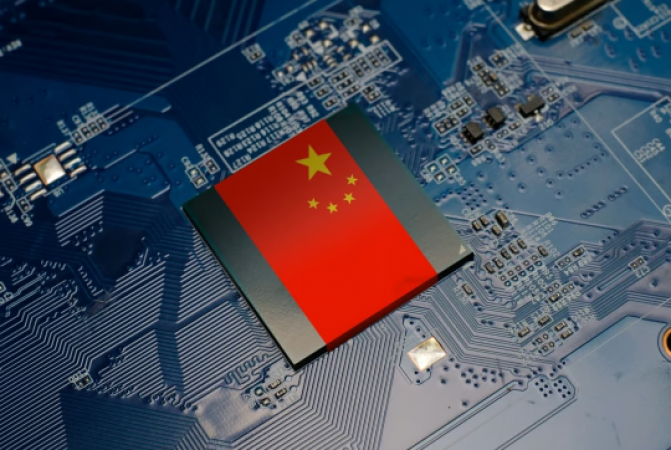
Beijing: Despite being added to a US trade blacklist, a Chinese chip designer whose goal has been to lessen the nation's reliance on Intel and AMD is attempting to develop its own general-purpose graphic processing unit (GPU).
According to a response to questions from investors this week, Loongson Technology Corp, whose founder Hu Weiwu frequently cited Mao Zedong to express his aspirations, is evaluating the cutting-edge 7-nanometer process from a number of foundries to produce its future chips.
The new chips would include central processing units (CPUs), a market long dominated by Intel and AMD, as well as graphics processing units (GPUs) similar to those provided by market leader Nvidia, which is currently prohibited from selling its high-end chips to Chinese customers.
The remarks by Loongson come a week after the US Bureau of Industry and Security (BIS) added the Beijing-based chip designer, whose Chinese name translates to "dragon chips," along with 26 other mainland entities, to the Entity List. US exporters must apply for special permits from Washington to sell products to companies on the list.
However, the stated goal of Shanghai-listed Loongson has always been to lessen China's reliance on US technologies. According to publicly available records, Loongson claimed that the most recent restrictions will not have any "material impact" as investors flooded the official enquiry platform run by the Shanghai Stock Exchange with inquiries about its product development and the effects of US sanctions.
Although Loongson is subject to fewer US sanctions than the Chinese telecoms giant Huawei Technologies Co., analysts warned that the chip designer's efforts to secure foundry services could be jeopardised if US-origin technologies are used in the manufacturing procedures.
Stewart Randall, head of electronics and embedded software at consultancy Intralink, questioned the point of designing cutting-edge chips for a fabless company without access to the best process nodes.
According to its prospectus for a Shanghai initial public offering last year, in which it raised 2.46 billion yuan (US$357 million), Loongson launched its in-house 3A5000 central processing unit (CPU) at the end of 2020, which was made on a now-restricted process node of 14-nm.
Also Read: Researchers might just have discovered the secret of how smell sense works
According to the company's prospectus, from 2019 to 2021, an unnamed foundry with the codename BP00 received more than half of its orders for chip manufacturing. At the time, Loongson issued a warning that "radical changes" in the world's geopolitical environment could disrupt its foundry supply.
Semiconductor Manufacturing International Corp. is the only foundry in China that can produce chips with a 14-nm manufacturing process (SMIC). Last year, SMIC reportedly succeeded in manufacturing a 7-nm chip, but the Shanghai-based business has never formally confirmed or denied the achievement.
After the central government promised to mobilise more resources to further support the development of technologies seen as crucial amid intensifying US-China tech rivalry, the Chinese semiconductor industry is betting that more support is on the way.
Beijing approved a revamp of the Ministry of Science and Technology as part of a larger reform plan during the nation's annual political gatherings, which ended earlier this week.
The ministry's mandates will be reduced as a result of the restructuring, forcing it to concentrate all of its efforts on translating scientific research into technologies for industrial production. Chinese news outlet Caixin cited Sun Yutao, an economics professor at Dalian University of Technology, as saying.
Insiders in the chip industry, however, claimed that it would be difficult to reduce short-term foreign dependence, particularly on cutting-edge equipment and expensive materials.
As the nation's premier institution for scientific and technological research, the Chinese Academy of Sciences, where Loongson was first established, in 2001. For the purpose of commercialising its chip development research, it was spun out as a separate entity in 2010.
The company operates as a so-called fabless company and specialises in providing CPUs, its own chip-based servers, and an instruction set architecture (ISA) called Loongson Architecture (LoongArch), which is based on the RISC principles that define a CPU's fundamental computing rules.
In 2011 and 2017, Loongson obtained technology licences from MIPS Computer Systems in the US, allowing it to design, manufacture, and market chips that use the MIPS instruction set architecture. According to Loongson's prospectus, MIPS ISA-based chips accounted for 70% of the company's overall sales from 2019 to 2021.
In April 2020, it put a hold on the renewal of the MIPS licence agreement because of a legal dispute with CIP United, a Shanghai-based semiconductor IP firm.
After acquiring an IP portfolio from MIPS, CIP United sued Loongson, claiming that both LoongArch and the 3A5000 CPU violated its copyright. According to a Loongson stock filing in March, the 60 million yuan lawsuits are still being processed in a Beijing civil court.
Also Read: Elon Musk recently shared a new batch of Twitter updates.
In order to develop its next-generation CPUs, known as the 3A6000 and 3A7000, Loongsoon has switched to its Loongson Architecture. The company said its architecture is compatible with Intel's proprietary X86 architecture, Arm's instruction set, and the open-sourced RISC-V, which has seen growing interest among Chinese firms amid ongoing US-China tensions.
In its prospectus, the company stated that it aims to compete with the dominant Arm-Google Android and Intel-Microsoft ecosystems by creating a "independent ecosystem" using its Loongson Architecture, Loongnix operating system, CPUs, and intellectual property.